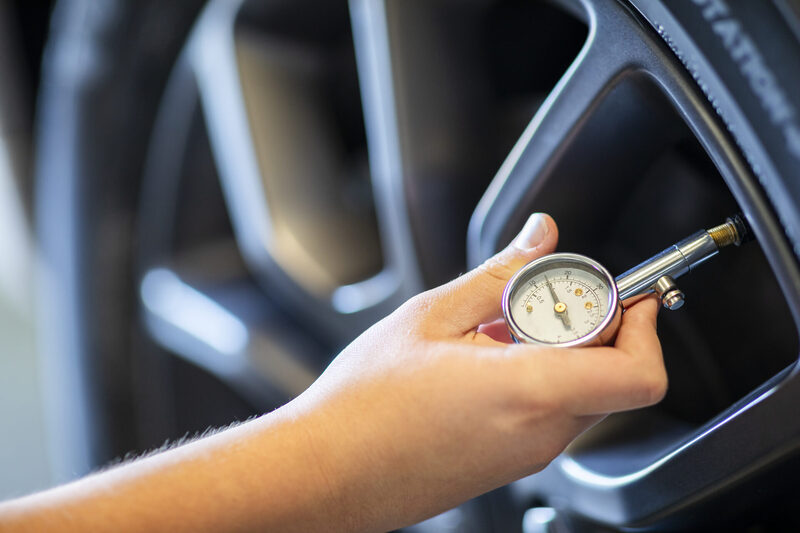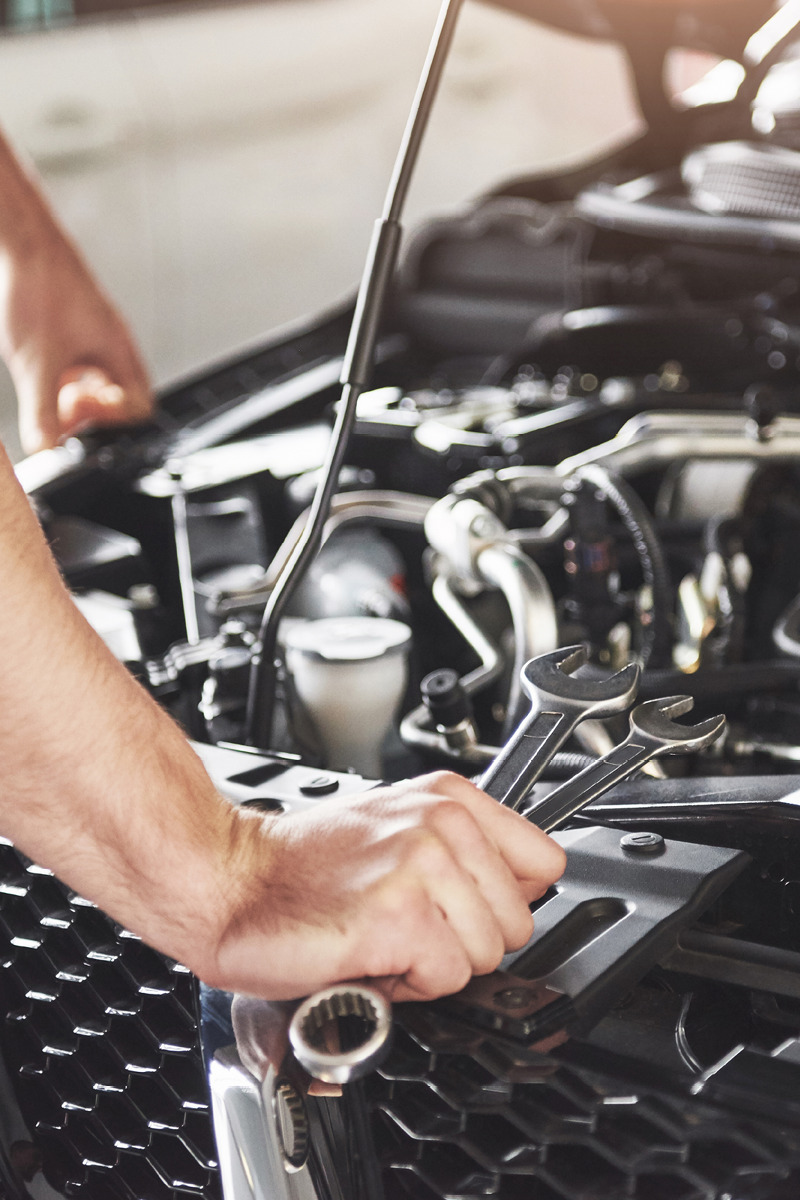
Checking your tyre pressure regularly is one of the simplest ways to improve safety, fuel efficiency and tyre longevity.
If you’re not sure how to check your tyre pressure, fortunately it’s quick and easy – here’s everything you need to know.
When should I check my tyres?
Your tyre pressure should be checked weekly. Always check before:
- A long journey
- Carrying a heavier load
- Seasonal weather changes
Keeping tyre pressure correct helps you avoid the dreaded “check tyre pressure” dashboard warning light, and reduces the risk of costly tyre or suspension repairs.
Alongside pressure, also monitor:
- Tyre tread depth
- Wheel alignment
- Vehicle load
- Seasonally appropriate tyres

What do I need to check my tyre pressure?
You don’t need specialist equipment, just a tyre pressure gauge (digital, analogue or stick). Many petrol stations provide these if you don’t own one.
Tyre pressure guage:
You can test your tyre pressure by using a tyre pressure gauge, which is sometimes known as a tyre checker. This is technically checking how many air atoms you have. The more air atoms you have, the more atom collisions there are which increases the pressure on the sides of the tyre (but in simple terms, it will tell you if your pressure is too low or too high). There are a few different types of gadgets to measure this, including stick, analogue and digital devices. Even if you don’t have a tyre pressure gauge, your local fuel station likely does.

Air pressure:
“How do I know my tyre pressure?” is a common question that many of us might feel confused about, especially if the panic of the warning light’s appearance has already set in. Keep calm though, checking and reading tyre pressure is quite straightforward.
The air pressure in tyres is commonly measured in PSI (pounds per square inch). Occasionally, you may see that the pressure is measured in Bars. It’s easy to calculate the conversion though, 1 Bar = 14.5 PSI.
The gauge will show the reading via displaying the number on the screen or the circular dial, this depends on what type of tyre checker or pressure gauge you’re using.
Note: Most car manufacturers recommend 33-36 PSI, however individual car brands and models have different guidelines on air pressure. It’s essential that you check what PSI is correct for your vehicle, to avoid over or under-inflation.
Where can I find information on my tyre pressure?
You can find this information in your vehicle handbook, the sill of your driver’s door, and possibly inside your fuel cap. Your tyre pressure sticker will have a list of tyre sizes, so you need to make sure that you read the correct PSI for the tyres that you have fitted on your vehicle.
Many vehicles have several tyres which are compatible with them, so it’s best to check. Tyre pressure charts are also helpful to confirm which measurement of air pressure is suitable for your vehicle.

Modern vehicles:
Checking and adjusting your tyre pressure and dealing with any issues that may be brought to your attention as a result of this, is generally a similar process for all drivers. Possibly the only exception to this would be high-performance car owners, who are typically advised to be more cautious.
High-performance tyres may not be repairable, if you do find a slow puncture. This is because some tyre speed ratings can be put under high stress. Additionally, run-flat tyres have become more common now and are different to standard tyres. They are reinforced tyres that can run even when deflated, in case of an emergency. These tyres are more expensive and can rarely be repaired.
Tyre compressor:
As highlighted previously, many new cars are compatible with quite a few different types of tyres. An example of this is Lotus, who works with a number of leading tyre manufacturers. The air pressures for these different tyres can be between 30 and 36 PSI. This means that extra attention needs to be paid to the corresponding PSI to the tyre type.
Most newer vehicles have a tyre pressure monitoring system (TPMS) fitted, which alerts you if the tyre pressure increases or decreases. This is a big help for drivers and is the system which causes the check tyre pressure light to illuminate – reducing the risks of unknowingly driving with an unsafe tyre. In 2015, the UK government passed legislation which states that vehicles first used on or after 1 January 2012 with an inoperative or faulty TPMS face an immediate MOT failure.
Tyre compressors are used for tyre inflation and can be found in almost all fuel stations. Some people may have their own air compressors for cars, which can be especially useful if the vehicle is not at all driveable.
They are pneumatic devices that convert power into potential energy – as compressed air. These machines come in all sorts of forms; from plug-in tyre inflators which plug directly into your vehicle, to handheld rechargeable gadgets, to larger ones that plug into the mains. Most air compressors have integrated control panels as well as built-in pressure gauges and regulators.
I don’t have the equipment I need:
If you’re heading to the forecourt to sort your tyre pressure, you need to be aware that checking tyre pressure after driving is likely to give you a misleading reading. This is because as you drive; the temperature of the tyres increases and so does the tyre pressure. So the hotter the tyres, the higher the pressure – giving you an unreliable reading.
Doing this check on your tyre pressure on hot tyres will probably result in underinflated tyres. Best way to avoid this is to check and maintain your tyre pressures at a nearby garage, especially at the start of a long journey. This will mean, the tyres are as cool as possible.
You may wonder where you can check and alter your tyre pressure for free. Another bonus of using a garage’s equipment is that many offer free tyre checking services. Additionally, if your tyre pressure is too low, air compressors at petrol stations cost as low as 10p per minute to use.

What happens if I don’t check the tyre pressure?
You may be able to tell if tyres need air by looking out for differences in your driving experience. If you notice any of the changes listed below, it could be a sign that your tyre pressure is low.
- Fuel consumption – uneven pressure can cause your vehicle to work harder, meaning you use more fuel.
- Braking distance – braking time will increase when pressure is low.
- Vehicle performance – handling accuracy can be affected by uneven tyre pressure.
- Uneven wear – low tyre pressure can cause uneven wear and tear on tyres.
- Punctures – tyres filled with less air are more prone to punctures.
6 tips for keeping your tyre pressure in top condition:
- Remove the valve dust cap from the tyre valve and place the pressure gauge securely onto the tyre valve stem.
- To ensure you get an accurate reading press down the gauge evenly on the valve stem.
- Check the reading on the pressure gauge to determine if you’ll need to inflate or deflate your tyres.
- If your tyres need inflating, use a suitable pump. Add small amounts of air at a time to avoid over-inflation.
- If your tyres need deflating, use the tip of a flat-head screwdriver to push on the metal pin on the valve stem to release air slowly.
- Take regular measurements with the pressure gauge between inflating and deflating.
Ensure you check your car tyres individually, as the pressure in each tyre can be very different. By checking your tyres regularly you can avoid unnecessary garage costs and possible road traffic accidents.
Bonus Tip – Check the pressure on your spare tyre too if you have one – you never know when you might need to use it!
Where we can help with persisting problems:
If you have completed the above steps and your tyre pressure still seems inaccurate, you may have a slow puncture or have checked the tyre pressure when hot.
The outdoor temperature changes optimal tyre pressure. You should add or remove 3-5 PSI to your vehicle’s guideline PSI, during hot or cold weather.
Can slow punctures be repaired? Possibly. This depends on what is causing the puncture. It is best to visit a garage or a tyre specialist, who can assess the damage. Sometimes, nails and debris can be removed, and tyres can be fixed via plugging the puncture, usually at fairly low prices.

Alternatively, if issues such as the steering pulling to one side or a constant warning light persist, you may have a more complicated issue such as wheel dealignment or a connection problem within your motor’s computer.
Find out how you can try to prevent these hiccups in caring for your vehicle correctly.
Remember, we provide one of the UK’s most comprehensive warranties so if you don’t have one yet, you can find out more about what Warrantywise offer or contact us on 0800 001 4990.
Discover more.
Further Warrantywise articles you might find useful

How to save money by caring for your car.
With fuel prices, repairs, and car costs rising, saving money on your vehicle has never been more important. The good … Continued

6 essential fluids that keep your car healthy and how to maintain them.
Keeping your car’s fluids at the right levels is essential for performance and longevity. From engine oil and coolant, to … Continued

This is how often you should replace your car battery.
On average, car batteries last for three years with normal care and maintenance. The average cost of replacing a car … Continued